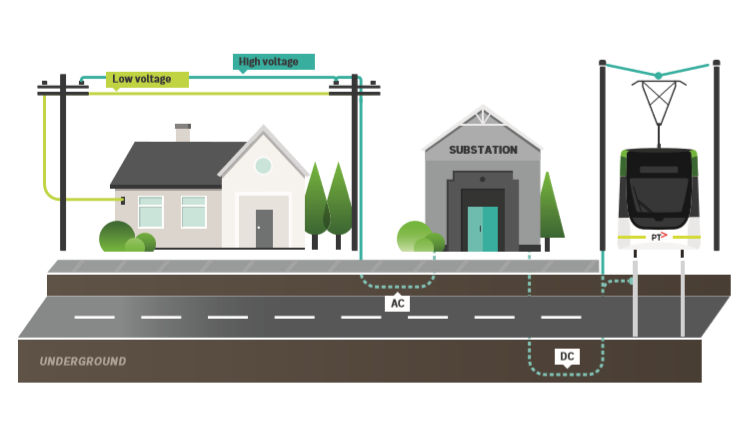Introduction to tram substations
Tram substations contain electrical equipment to convert the local power supply into the voltage needed to run the tram network.
Power going into the substation comes from the existing local power lines in the street.
Inside the building there's a transformer that converts the high-voltage power from the street into a lower voltage. This power is used by the substation’s rectifier – a piece of equipment that converts the power from AC (alternating current) to DC (direct current) so it can be used by trams. The remaining equipment in the substation allows for safe switching, operation and maintenance of the substation.
Power from the substation to the tram line is connected via underground cables to the tram network. Tram substations don't generate their own power.
We’re designing all new tram substations (regardless of where they're sited) to ensure they meet all relevant safe operating standards and guidelines and operate with minimal impact on the local community.

Where can you find substations?
People often think of the large outdoor zone substations associated with high voltage transmission powerlines. But there are many smaller power distribution substations that convert HV (high voltage) power to LV (low voltage) for supplying power to homes. These are found throughout residential areas (often on poles adjacent to houses). In the inner city they're commonly housed on the ground floor of apartment buildings as well as next to offices and cafés.
The output of tram substations is similar to small power-distribution substations. There are currently 60 tram substations spread throughout Melbourne’s suburbs, with at least another 30 planned.
Do substations produce electromagnetic fields (EMF)?
Electromagnetic emissions or electromagnetic fields (EMF) are present naturally in the environment through phenomena like the earth’s magnetic field and thunderstorms.
As a byproduct of electricity, EMFs occur around all electrical items including household appliances like computers, electric stoves, televisions, kettles, toasters and hairdryers as well as the power lines providing electricity directly to your home.
The World Health Organization has concluded that despite extensive research, to date there's no evidence that exposure to low-level electromagnetic fields is harmful to human health.
The Australian Radiation Protection and Nuclear Agency (ARPANSA) adopts international standards for exposure to electric and magnetic fields that have been set based on evidence from scientific studies.
EMF levels found outside tram substations are well below the limits set by these international standards.
ARPANSA states that “There is no established evidence that magnetic fields at any distance from a substation/transformer cause health effects."